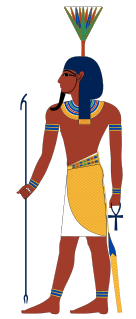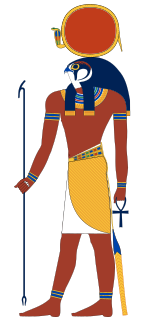
Zagazig is a city in Lower Egypt. Situated in the eastern part of the Nile delta, it is the capital of the governorate of Sharqia.

Nefertem was, in Egyptian mythology, originally a lotus flower at the creation of the world, who had arisen from the primal waters. Nefertem represented both the first sunlight and the delightful smell of the Egyptian blue lotus flower, having arisen from the primal waters within an Egyptian blue water-lily, Nymphaea caerulea. Some of the titles of Nefertem were "He Who is Beautiful" and "Water-Lily of the Sun", and a version of the Book of the Dead says:
Rise like Nefertem from the blue water lily, to the nostrils of Ra, and come forth upon the horizon each day.

Bastet or Bast was a goddess of ancient Egyptian religion, worshiped as early as the Second Dynasty. Her name also is rendered as B'sst, Baast, Ubaste, and Baset. In ancient Greek religion, she was known as Ailuros.

A mascot is any person, animal, or object thought to bring luck, or anything used to represent a group with a common public identity, such as a school, professional sports team, society, military unit, or brand name. Mascots are also used as fictional, representative spokespeople for consumer products, such as the rabbit used in advertising and marketing for the General Mills brand of breakfast cereal, Trix.

Bubastis, also known in Arabic as Tell-Basta or in Egyptian as Per-Bast, was an Ancient Egyptian city. Bubastis is often identified with the biblical Pi-Beseth. It was the capital of its own nome, located along the River Nile in the Delta region of Lower Egypt, and notable as a center of worship for the feline goddess Bastet, and therefore the principal depository in Egypt of mummies of cats.

Titkheperure or Tyetkheperre Psusennes II [Greek Ψουσέννης] or Hor-Pasebakhaenniut II [Egyptian ḥr-p3-sb3-ḫˁỉ-⟨n⟩-nỉwt], was the last king of the Twenty-first dynasty of Egypt. His royal name means "Image of the transformations of Re" in Egyptian. Psusennes II is often considered the same person as the High-Priest of Amun known as Psusennes III. The Egyptologist Karl Jansen-Winkeln notes that an important graffito from the Temple of Abydos contains the complete titles of a king Tyetkheperre Setepenre Pasebakhaenniut Meryamun "who is simultaneously called the HPA and supreme military commander." This suggests that Psusennes was both king at Tanis and the High Priest in Thebes at the same time, meaning he did not resign his office as High Priest of Amun during his reign. The few contemporary attestations from his reign include the aforementioned graffito in Seti I's Abydos temple, an ostracon from Umm el-Qa'ab, an affiliation at Karnak and his presumed burial – which consists of a gilded coffin with a royal uraeus and a Mummy, found in an antechamber of Psusennes I's tomb at Tanis. He was a High Priest of Amun at Thebes and the son of Pinedjem II and Istemkheb. His daughter Maatkare B was the Great Royal Wife of Osorkon I.
In Egyptian mythology, Pakhet, Egyptian Pḫ.t, meaning she who scratches is a lioness goddess of war.

Cats in ancient Egypt were represented in social and religious practices of Ancient Egypt for more than 30 centuries. Several Ancient Egyptian deities were depicted and sculptured with cat-like heads such as Mafdet, Bastet and Sekhmet, representing justice, fertility and power. The deity Mut was also depicted as a cat and in the company of a cat.

Pedubastis I or Pedubast I was an Upper Egyptian Pharaoh of Ancient Egypt during the 9th century BC. Based on lunar dates which are known to belong to the reign of his rival in Upper Egypt Takelot II and the fact that Pedubast I first appeared as a local king at Thebes around Year 11 of Takelot II's rule, Pedubast I is today believed to have had his accession date in either 835 BC or 824 BC. This local Pharaoh is recorded as being of Libyan ancestry and ruled Egypt for 25 years according to the redaction of Manetho done by Eusebius. He first became king at Thebes in Year 8 of Shoshenq III and his highest dated Year is his 23rd Year according to Nile Level Text No. 29. This year is equivalent to Year 31 of Shoshenq III of the Tanis based 22nd Dynasty of Egypt; however, since Shoshenq II only controlled Lower Egypt in Memphis and the Delta region, Pedubast and Shoshenq III were not political rivals and may even have established a relationship. Indeed, Shoshenq III's son, the general and army leader Pashedbast B "built a vestibule door to Pylon X at Karnak, and in one and the same commemorative text thereon named his father as [king] Sheshonq (III)" but dated his actions here to Pedubast I. This may show some tacit support for the Pedubast faction by the Tanite based 22nd dynasty king Shoshenq III.
The 11th Pan Arab Games took place in Cairo, Egypt from 11 – 26 November 2007. A total of 22 countries participated in 32 events. These games were the largest in the games' history; seven new events were introduced and 2000 more athletes participated than in previous years, making them 8000 Arab athletes. It was also the first time that some of the Arab football federations participated with their first teams.

The ancient residential diocese of Orange in the Comtat Venaissin in Provence, a fief belonging to the Papacy, was suppressed by the French government during the French Revolution. It was revived in 2009 as a titular see of the Roman Catholic Church.

Valentine is an American romantic comedy-drama television series that aired on The CW and City in Canada from October 5, 2008 to July 19, 2009. The series was created by Kevin Murphy, who also serves as executive producer alongside Courtney Conte. The show was produced by Media Rights Capital and aired on Sundays at 8:00pm. On November 20, 2008, CW pulled Valentine along with Easy Money. However, the series returned on Sunday, June 28, 2009 to begin burning-off the remaining unaired episodes. The show's only season averaged 0.72 million viewers and 0.2 demo in Adults 18-49.

Ra or Re is the ancient Egyptian deity of the sun. By the Fifth Dynasty in the 25th and 24th centuries BC, he had become one of the most important gods in ancient Egyptian religion, identified primarily with the noon sun. Ra was believed to rule in all parts of the created world: the sky, the Earth, and the underworld. He was the god of the sun, order, kings, and the sky.

Tutu was an Egyptian god worshipped by ordinary people all over Egypt during the Late Period. The only known temple dedicated to Tutu is located in ancient Kellis. However, reliefs depicting Tutu are seen in other temples, such as the Temple of Kalabsha. Tutu's title at the Shenhur temple was "Who comes to the one calling him". Other titles of his are "Son of Neith," "the Lion," "Great of Strength", and "Master of the demons of Sekhmet and the wandering demons of Bastet".
Evert Bastet is a Canadian sailor. He won a silver medal in the Flying Dutchman Class at the 1984 Summer Olympics with Terry McLaughlin. He also finished fourth within the same category at the 1976 Summer Olympics. He lives in Hudson, Québec.
Shesmetet(šsm.t.t) is an ancient Egyptian goddess. She was mentioned in the Pyramid Texts and was usually referred to as the deceased's mother. She was depicted as a lion or a woman with a lion's head, and thus was sometimes considered a form of Sekhmet or Bastet, but one of her epithets – "Lady of Punt" – differentiates her from them and may refer to a possible African origin. Her name comes from shesmet, a sash decorated with beads, which appears on the depictions of Old Kingdom rulers and the god Sopdu.

Ecstasy: A Study of Happiness is a novel written by Louis Couperus and published in 1892 by L.J. Veen in a first edition of 1,250–1,500 copies. A second edition was printed in 1894 and a third in 1905. Ecstasy was the first book of Couperus that was published by L.J. Veen, later his regular publisher. Couperus received a wage of 550 guilders for the first edition. Ecstasy was first published in the Dutch literary magazine The Gids. The book was translated into English by Alexander Teixeira de Mattos in 1919 and published by Dodd, Mead and Company.
The Bubasteum was a Ptolemaic and Roman temple complex dedicated to Bastet in the cliff face of the desert boundary of Saqqara. In Arabic the place is called Abwab el-Qotat.












